Page 1211 of 2896
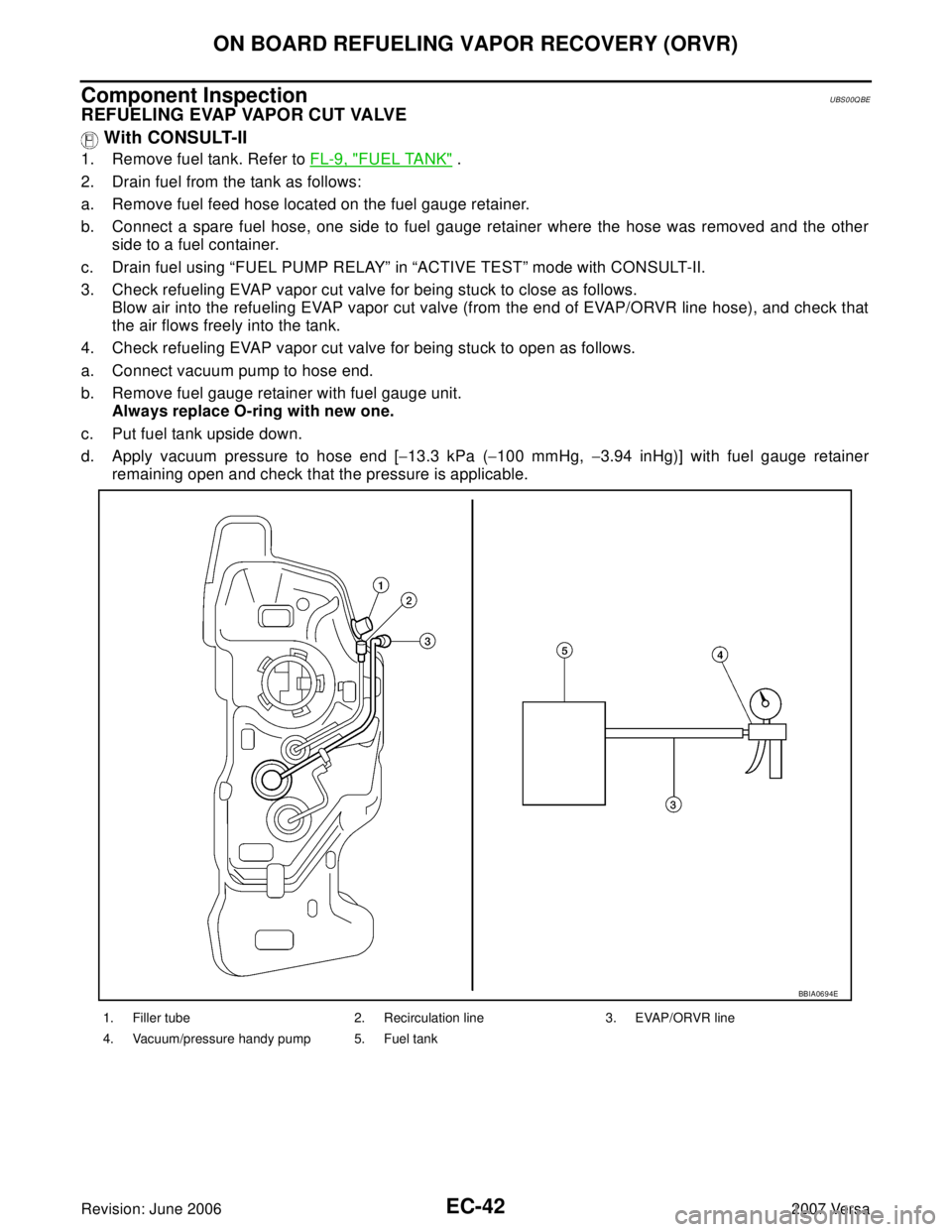
EC-42Revision: June 2006
ON BOARD REFUELING VAPOR RECOVERY (ORVR)
2007 Versa
Component InspectionUBS00QBE
REFUELING EVAP VAPOR CUT VALVE
With CONSULT-II
1. Remove fuel tank. Refer to FL-9, "FUEL TANK" .
2. Drain fuel from the tank as follows:
a. Remove fuel feed hose located on the fuel gauge retainer.
b. Connect a spare fuel hose, one side to fuel gauge retainer where the hose was removed and the other
side to a fuel container.
c. Drain fuel using “FUEL PUMP RELAY” in “ACTIVE TEST” mode with CONSULT-II.
3. Check refueling EVAP vapor cut valve for being stuck to close as follows.
Blow air into the refueling EVAP vapor cut valve (from the end of EVAP/ORVR line hose), and check that
the air flows freely into the tank.
4. Check refueling EVAP vapor cut valve for being stuck to open as follows.
a. Connect vacuum pump to hose end.
b. Remove fuel gauge retainer with fuel gauge unit.
Always replace O-ring with new one.
c. Put fuel tank upside down.
d. Apply vacuum pressure to hose end [−13.3 kPa (−100 mmHg, −3.94 inHg)] with fuel gauge retainer
remaining open and check that the pressure is applicable.
1. Filler tube 2. Recirculation line 3. EVAP/ORVR line
4. Vacuum/pressure handy pump 5. Fuel tank
BBIA0694E
Page 1212 of 2896
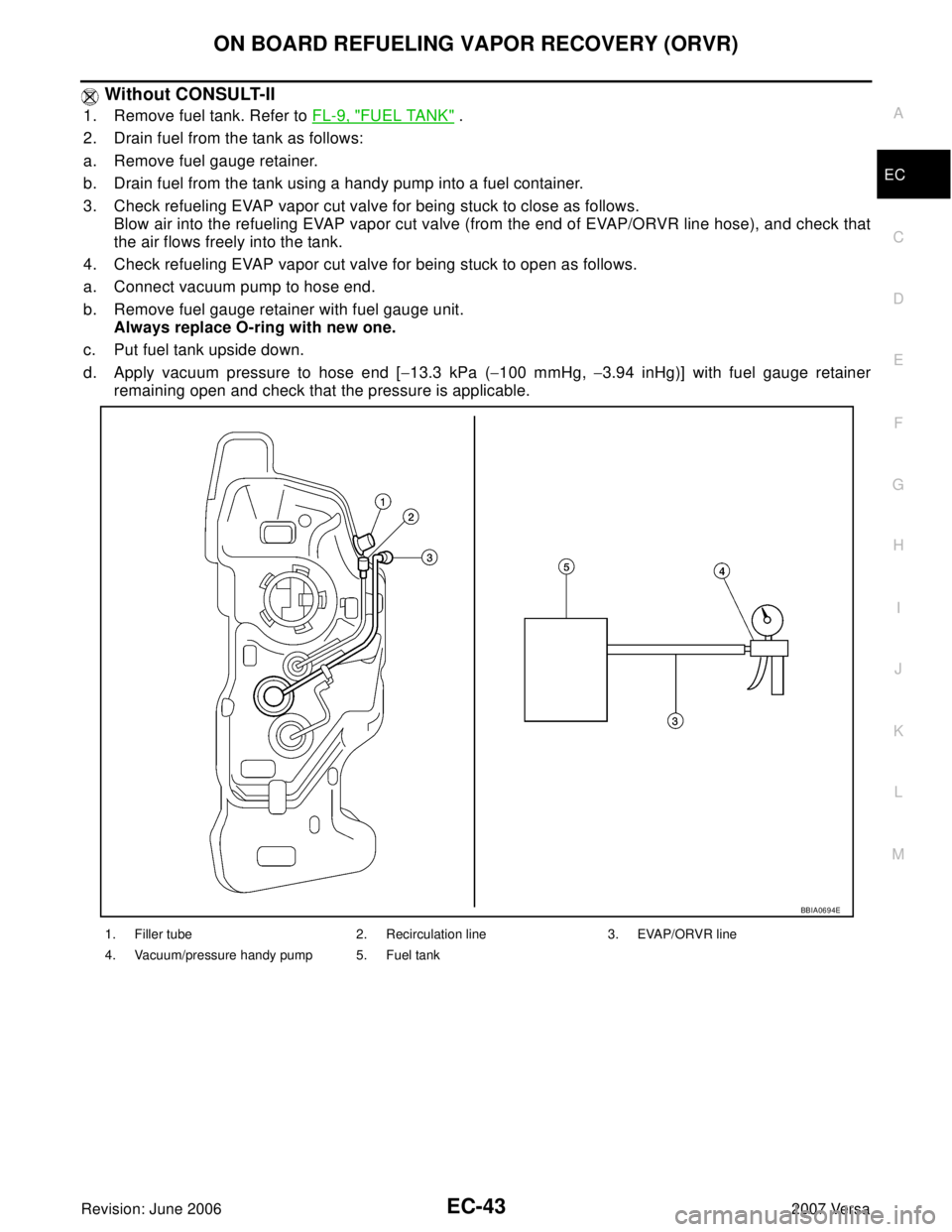
ON BOARD REFUELING VAPOR RECOVERY (ORVR)
EC-43
C
D
E
F
G
H
I
J
K
L
MA
EC
Revision: June 20062007 Versa
Without CONSULT-II
1. Remove fuel tank. Refer to FL-9, "FUEL TANK" .
2. Drain fuel from the tank as follows:
a. Remove fuel gauge retainer.
b. Drain fuel from the tank using a handy pump into a fuel container.
3. Check refueling EVAP vapor cut valve for being stuck to close as follows.
Blow air into the refueling EVAP vapor cut valve (from the end of EVAP/ORVR line hose), and check that
the air flows freely into the tank.
4. Check refueling EVAP vapor cut valve for being stuck to open as follows.
a. Connect vacuum pump to hose end.
b. Remove fuel gauge retainer with fuel gauge unit.
Always replace O-ring with new one.
c. Put fuel tank upside down.
d. Apply vacuum pressure to hose end [−13.3 kPa (−100 mmHg, −3.94 inHg)] with fuel gauge retainer
remaining open and check that the pressure is applicable.
1. Filler tube 2. Recirculation line 3. EVAP/ORVR line
4. Vacuum/pressure handy pump 5. Fuel tank
BBIA0694E
Page 1250 of 2896
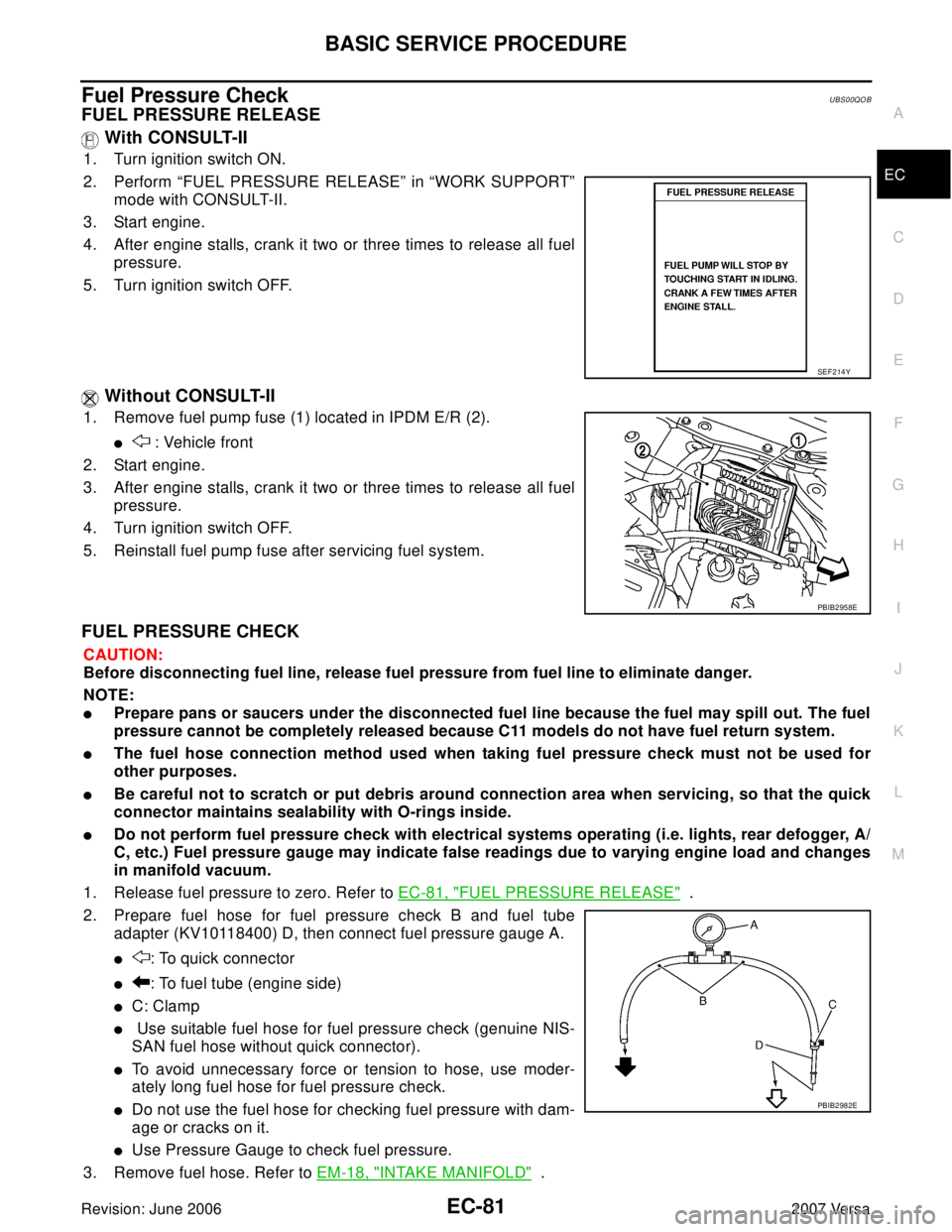
BASIC SERVICE PROCEDURE
EC-81
C
D
E
F
G
H
I
J
K
L
MA
EC
Revision: June 20062007 Versa
Fuel Pressure CheckUBS00QOB
FUEL PRESSURE RELEASE
With CONSULT-II
1. Turn ignition switch ON.
2. Perform “FUEL PRESSURE RELEASE” in “WORK SUPPORT”
mode with CONSULT-II.
3. Start engine.
4. After engine stalls, crank it two or three times to release all fuel
pressure.
5. Turn ignition switch OFF.
Without CONSULT-II
1. Remove fuel pump fuse (1) located in IPDM E/R (2).
� : Vehicle front
2. Start engine.
3. After engine stalls, crank it two or three times to release all fuel
pressure.
4. Turn ignition switch OFF.
5. Reinstall fuel pump fuse after servicing fuel system.
FUEL PRESSURE CHECK
CAUTION:
Before disconnecting fuel line, release fuel pressure from fuel line to eliminate danger.
NOTE:
�Prepare pans or saucers under the disconnected fuel line because the fuel may spill out. The fuel
pressure cannot be completely released because C11 models do not have fuel return system.
�The fuel hose connection method used when taking fuel pressure check must not be used for
other purposes.
�Be careful not to scratch or put debris around connection area when servicing, so that the quick
connector maintains sealability with O-rings inside.
�Do not perform fuel pressure check with electrical systems operating (i.e. lights, rear defogger, A/
C, etc.) Fuel pressure gauge may indicate false readings due to varying engine load and changes
in manifold vacuum.
1. Release fuel pressure to zero. Refer to EC-81, "
FUEL PRESSURE RELEASE" .
2. Prepare fuel hose for fuel pressure check B and fuel tube
adapter (KV10118400) D, then connect fuel pressure gauge A.
�: To quick connector
�: To fuel tube (engine side)
�C: Clamp
� Use suitable fuel hose for fuel pressure check (genuine NIS-
SAN fuel hose without quick connector).
�To avoid unnecessary force or tension to hose, use moder-
ately long fuel hose for fuel pressure check.
�Do not use the fuel hose for checking fuel pressure with dam-
age or cracks on it.
�Use Pressure Gauge to check fuel pressure.
3. Remove fuel hose. Refer to EM-18, "
INTAKE MANIFOLD" .
SEF 2 14 Y
PBIB2958E
PBIB2982E
Page 1251 of 2896
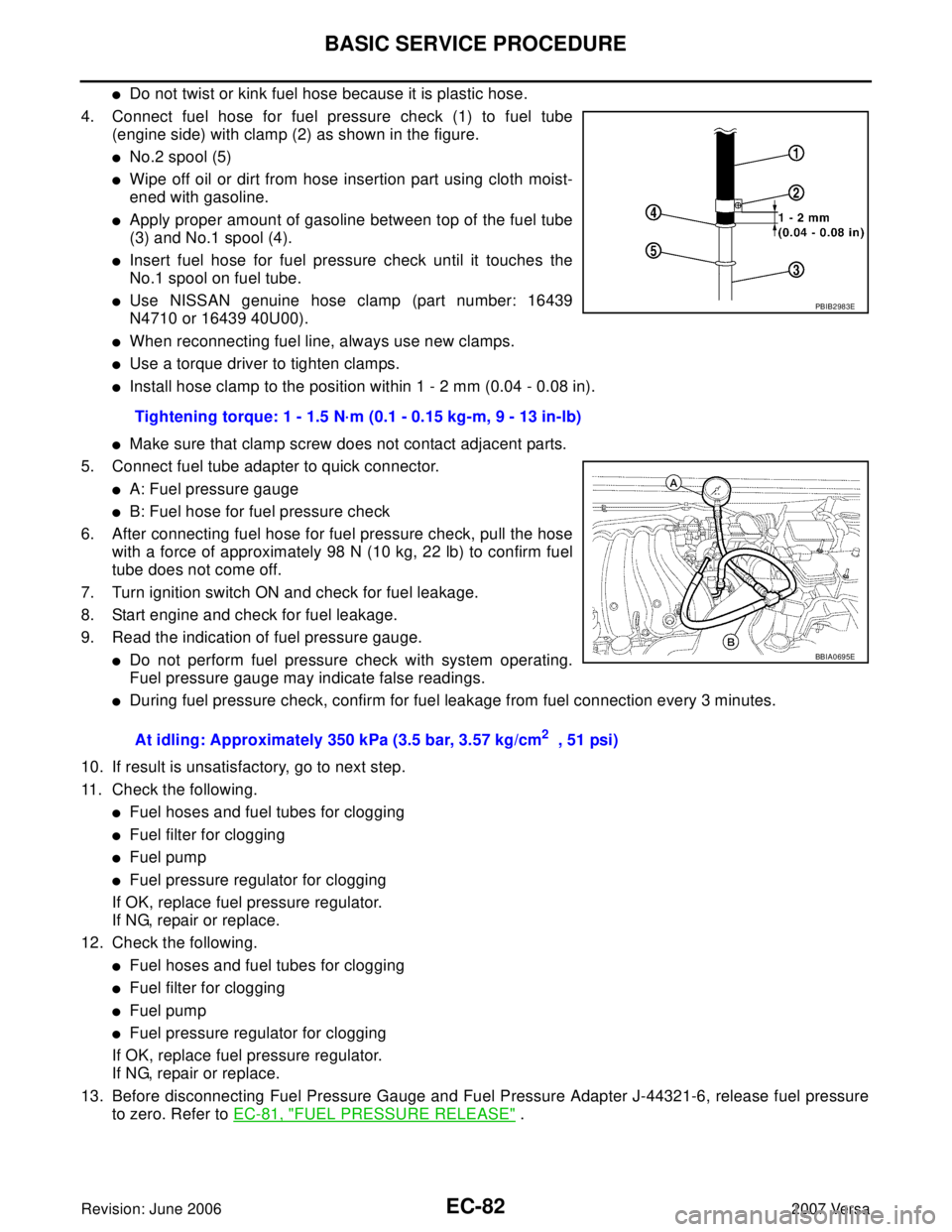
EC-82Revision: June 2006
BASIC SERVICE PROCEDURE
2007 Versa
�Do not twist or kink fuel hose because it is plastic hose.
4. Connect fuel hose for fuel pressure check (1) to fuel tube
(engine side) with clamp (2) as shown in the figure.
�No.2 spool (5)
�Wipe off oil or dirt from hose insertion part using cloth moist-
ened with gasoline.
�Apply proper amount of gasoline between top of the fuel tube
(3) and No.1 spool (4).
�Insert fuel hose for fuel pressure check until it touches the
No.1 spool on fuel tube.
�Use NISSAN genuine hose clamp (part number: 16439
N4710 or 16439 40U00).
�When reconnecting fuel line, always use new clamps.
�Use a torque driver to tighten clamps.
�Install hose clamp to the position within 1 - 2 mm (0.04 - 0.08 in).
�Make sure that clamp screw does not contact adjacent parts.
5. Connect fuel tube adapter to quick connector.
�A: Fuel pressure gauge
�B: Fuel hose for fuel pressure check
6. After connecting fuel hose for fuel pressure check, pull the hose
with a force of approximately 98 N (10 kg, 22 lb) to confirm fuel
tube does not come off.
7. Turn ignition switch ON and check for fuel leakage.
8. Start engine and check for fuel leakage.
9. Read the indication of fuel pressure gauge.
�Do not perform fuel pressure check with system operating.
Fuel pressure gauge may indicate false readings.
�During fuel pressure check, confirm for fuel leakage from fuel connection every 3 minutes.
10. If result is unsatisfactory, go to next step.
11. Check the following.
�Fuel hoses and fuel tubes for clogging
�Fuel filter for clogging
�Fuel pump
�Fuel pressure regulator for clogging
If OK, replace fuel pressure regulator.
If NG, repair or replace.
12. Check the following.
�Fuel hoses and fuel tubes for clogging
�Fuel filter for clogging
�Fuel pump
�Fuel pressure regulator for clogging
If OK, replace fuel pressure regulator.
If NG, repair or replace.
13. Before disconnecting Fuel Pressure Gauge and Fuel Pressure Adapter J-44321-6, release fuel pressure
to zero. Refer to EC-81, "
FUEL PRESSURE RELEASE" . Tightening torque: 1 - 1.5 N·m (0.1 - 0.15 kg-m, 9 - 13 in-lb)
At idling: Approximately 350 kPa (3.5 bar, 3.57 kg/cm
2 , 51 psi)
PBIB2983E
BBIA0695E
Page 1261 of 2896

EC-92Revision: June 2006
TROUBLE DIAGNOSIS
2007 Versa
Symptom Matrix ChartUBS00PKH
SYSTEM — BASIC ENGINE CONTROL SYSTEM
SYMPTOM
Reference
page
HARD/NO START/RESTART (EXCP. HA)
ENGINE STALL
HESITATION/SURGING/FLAT SPOT
SPARK KNOCK/DETONATION
LACK OF POWER/POOR ACCELERATION
HIGH IDLE/LOW IDLE
ROUGH IDLE/HUNTING
IDLING VIBRATION
SLOW/NO RETURN TO IDLE
OVERHEATS/WATER TEMPERATURE HIGH
EXCESSIVE FUEL CONSUMPTION
EXCESSIVE OIL CONSUMPTION
BATTERY DEAD (UNDER CHARGE)
Warranty symptom code AA AB AC AD AE AF AG AH AJ AK AL AM HA
Fuel Fuel pump circuit 1 1 2 3 2 2 2 3 2EC-570
Fuel pressure regulator system 3 3 4 4 4 4 4 4 4 4EC-81
Fuel injector circuit 1 1 2 3 2 2 2 2EC-564
Evaporative emission system 3 3 4 4 4 4 4 4 4 4EC-31
Air Positive crankcase ventilation sys-
tem
334444444 41EC-44
Incorrect idle speed adjustment 1 1 1 1 1EC-70
Electric throttle control actuator 1 1 2 3 3 2 2 2 2 2 2EC-499,
EC-511
Ignition Incorrect ignition timing adjustment 3 3 1 1 1 1 1 1EC-70
Ignition circuit 1 1 2 2 2 2 2 2EC-576
Main power supply and ground circuit 2 2 3 3 3 3 3 2 3EC-144
Mass air flow sensor circuit
1
122
222 2EC-178,
EC-187
Engine coolant temperature sensor circuit
333EC-200,
EC-212
Air fuel ratio (A/F) sensor 1 circuitEC-220
,
EC-227
,
EC-233
,
EC-239
,
EC-540
Throttle position sensor circuit
22EC-206
,
EC-302
,
EC-460
,
EC-462
,
EC-526
Accelerator pedal position sensor circuit 3 2 1EC-430
,
EC-513
,
EC-519
,
EC-532
Knock sensor circuit 2 3EC-315
Crankshaft position sensor (POS) circuit 2 2EC-319
Camshaft position sensor (PHASE) circuit 3 2EC-327
Vehicle speed signal circuit 2 3 3 3EC-421
ECM 22333333333EC-427
Page 1263 of 2896
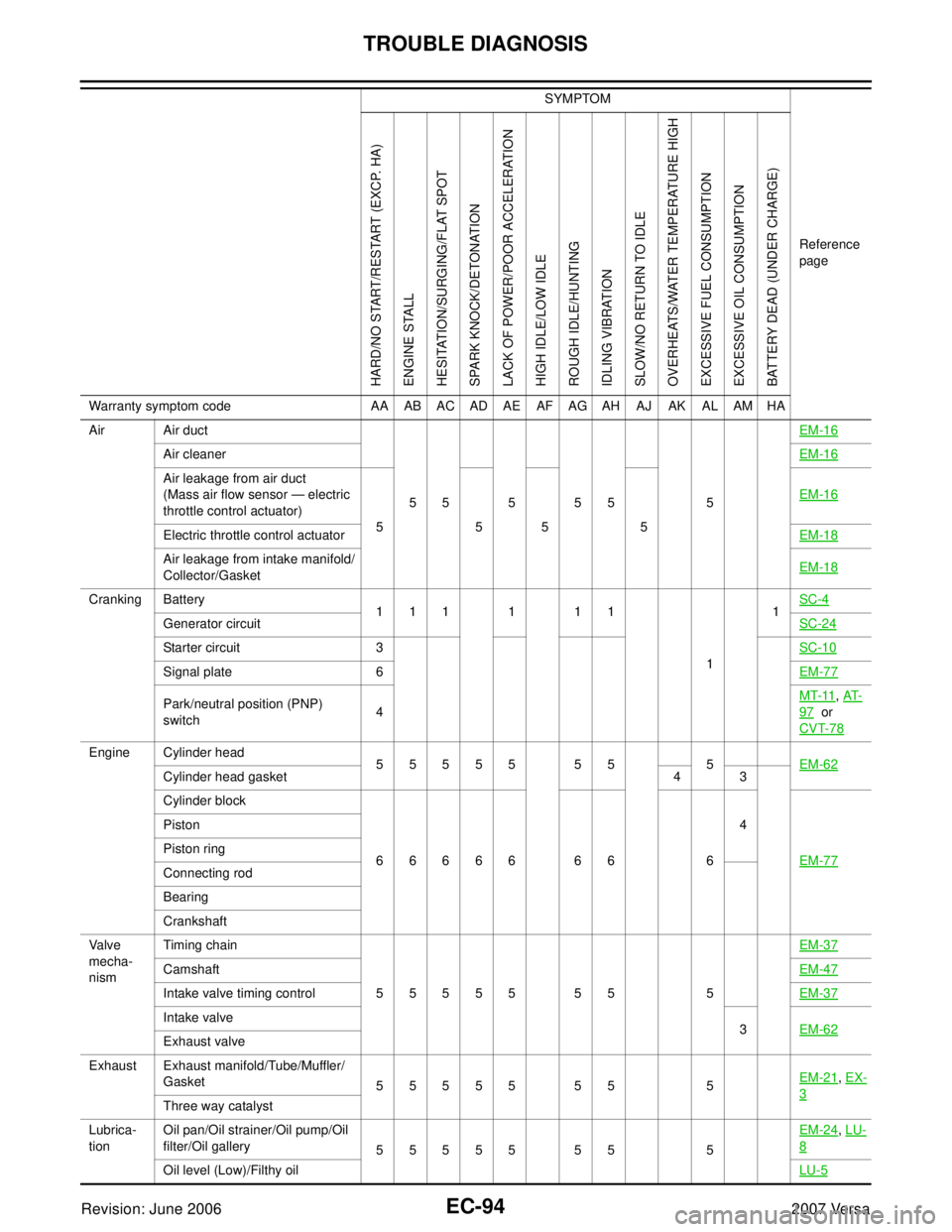
EC-94Revision: June 2006
TROUBLE DIAGNOSIS
2007 Versa
Air Air duct
55555 5EM-16
Air cleanerEM-16
Air leakage from air duct
(Mass air flow sensor — electric
throttle control actuator)
5555EM-16
Electric throttle control actuatorEM-18
Air leakage from intake manifold/
Collector/GasketEM-18
Cranking Battery
111111
11SC-4
Generator circuitSC-24
Starter circuit 3SC-10
Signal plate 6EM-77
Park/neutral position (PNP)
switch4MT-11, AT-
97 or
CVT-78
Engine Cylinder head
55555 55 5EM-62
Cylinder head gasket 4 3
Cylinder block
66666 66 64
EM-77
Piston
Piston ring
Connecting rod
Bearing
Crankshaft
Va lv e
mecha-
nismTiming chain
55555 55 5EM-37
CamshaftEM-47
Intake valve timing controlEM-37
Intake valve
3EM-62
Exhaust valve
Exhaust Exhaust manifold/Tube/Muffler/
Gasket
55555 55 5EM-21
, EX-
3Three way catalyst
Lubrica-
tionOil pan/Oil strainer/Oil pump/Oil
filter/Oil gallery
55555 55 5EM-24
, LU-
8
Oil level (Low)/Filthy oilLU-5
SYMPTOM
Reference
page
HARD/NO START/RESTART (EXCP. HA)
ENGINE STALL
HESITATION/SURGING/FLAT SPOT
SPARK KNOCK/DETONATION
LACK OF POWER/POOR ACCELERATION
HIGH IDLE/LOW IDLE
ROUGH IDLE/HUNTING
IDLING VIBRATION
SLOW/NO RETURN TO IDLE
OVERHEATS/WATER TEMPERATURE HIGH
EXCESSIVE FUEL CONSUMPTION
EXCESSIVE OIL CONSUMPTION
BATTERY DEAD (UNDER CHARGE)
Warranty symptom code AA AB AC AD AE AF AG AH AJ AK AL AM HA
Page 1267 of 2896
EC-98Revision: June 2006
TROUBLE DIAGNOSIS
2007 Versa
: Vehicle front
1. Intake valve timing control solenoid
valve2. Knock sensor 3. IPDM E/R
4. Fuel pump fuse (15A) 5. Fuel level sensor unit and fuel pump
harness connector (view with
inspection hole cover removed)6. Fuel level sensor unit and fuel pump
7. Fuel pressure regulator 8. Fuel level sensor 9. Fuel tank temperature sensor
10. Ignition coil
(with power transistor) and spark plug11. Fuel injector
BBIA0725E
Page 1276 of 2896
![NISSAN LATIO 2007 Service Repair Manual TROUBLE DIAGNOSIS
EC-107
C
D
E
F
G
H
I
J
K
L
MA
EC
Revision: June 20062007 Versa
13 L Tachometer signal[Engine is running]
�Warm-up condition
�Idle speed
NOTE:
The pulse cycle changes depending on rpm NISSAN LATIO 2007 Service Repair Manual TROUBLE DIAGNOSIS
EC-107
C
D
E
F
G
H
I
J
K
L
MA
EC
Revision: June 20062007 Versa
13 L Tachometer signal[Engine is running]
�Warm-up condition
�Idle speed
NOTE:
The pulse cycle changes depending on rpm](/manual-img/5/57361/w960_57361-1275.png)
TROUBLE DIAGNOSIS
EC-107
C
D
E
F
G
H
I
J
K
L
MA
EC
Revision: June 20062007 Versa
13 L Tachometer signal[Engine is running]
�Warm-up condition
�Idle speed
NOTE:
The pulse cycle changes depending on rpm
at idle.3 - 5V
[Engine is running]
� Warm-up condition
�Engine speed: 2,000 rpm.3 - 5V
15 Y Throttle control motor relay[Ignition switch: OFF]BATTERY VOLTAGE
(11 - 14V)
[Ignition switch: ON]0 - 1.0V
17
18
21
22R
LG
G
SBIgnition signal No. 1
Ignition signal No. 2
Ignition signal No. 4
Ignition signal No. 3[Engine is running]
�Warm-up condition
�Idle speed
NOTE:
The pulse cycle changes depending on rpm
at idle.0 - 0.3V
[Engine is running]
� Warm-up condition
�Engine speed: 2,500 rpm.0.2 - 0.5V
23 GR Fuel pump relay[Ignition switch: ON]
�For 1 second after turning ignition switch
ON
[Engine is running]0 - 1.0V
[Ignition switch: ON]
�More than 1 second after turning ignition
switch ONBATTERY VOLTAGE
(11 - 14V) TERMI-
NAL
NO.WIRE
COLORITEM CONDITION DATA (DC Voltage)
PBIA8164J
PBIA8165J
PBIA9265J
PBIA9266J